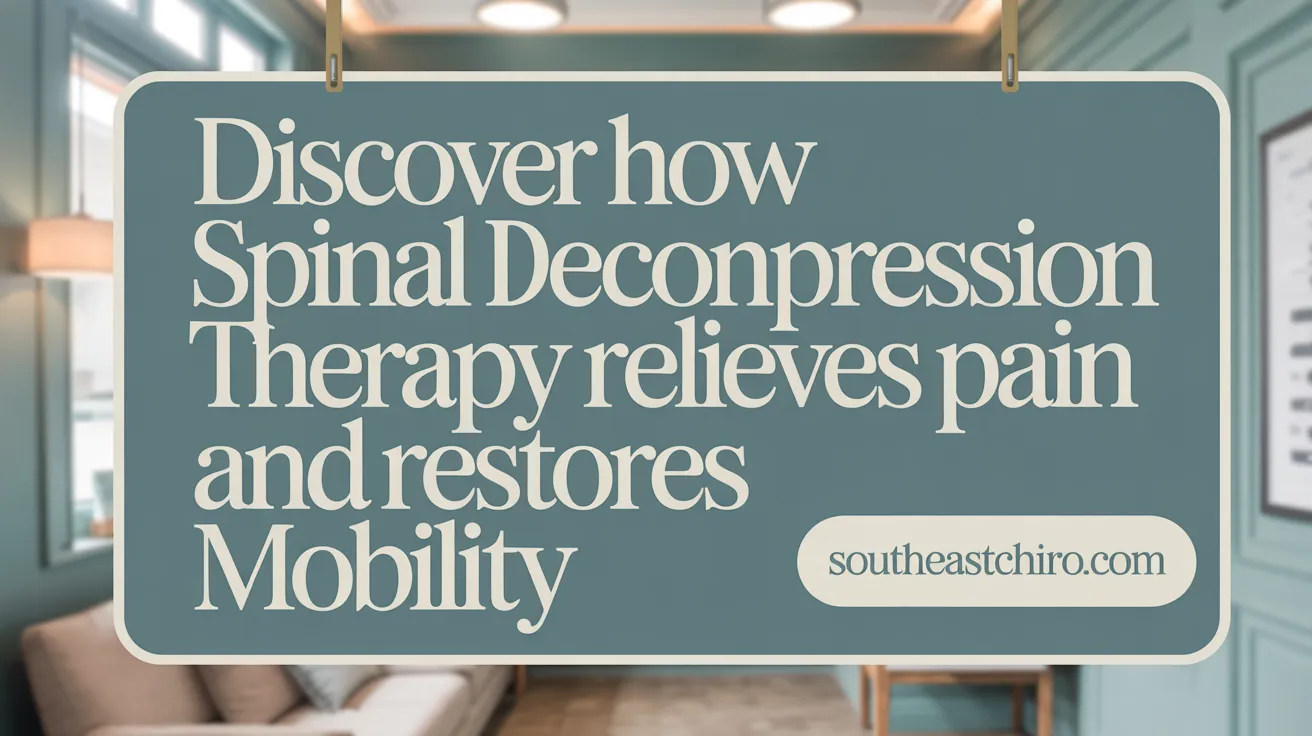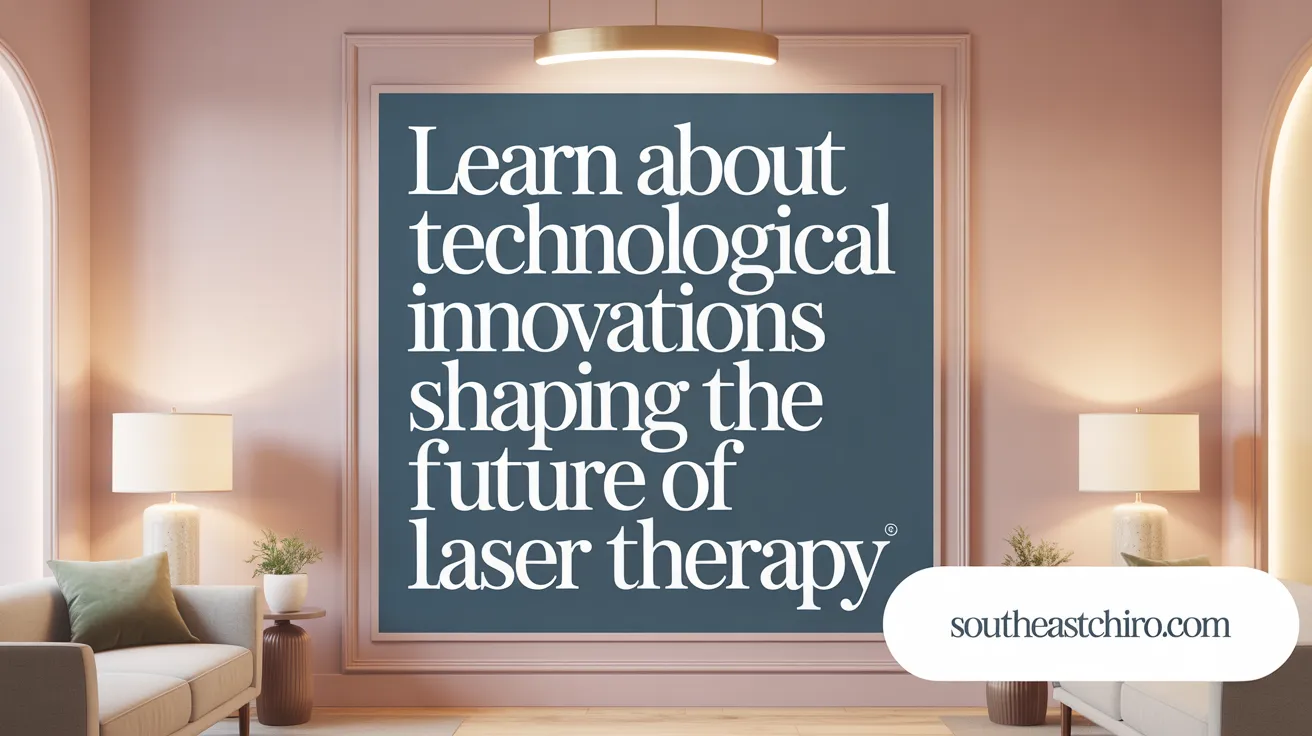Introduction to Laser Therapy and Spinal Decompression
Overview of Laser Therapy and Spinal Decompression
Laser therapy, also known as low-level laser therapy (LLLT) or cold laser therapy, uses focused light at specific wavelengths to stimulate cellular function. It promotes healing, reduces inflammation, and alleviates pain without heat, making it safe and painless for various conditions such as chronic back pain and arthritis.
Spinal decompression, on the other hand, is a non-invasive treatment that gently stretches the spine to relieve pressure on spinal discs and nerves. This creates negative pressure within discs, helping retract herniated or bulging discs, reduce nerve compression, and promote natural healing.
Non-Invasive Treatment Options in Chiropractic Care
Both laser therapy and spinal decompression are widely used within chiropractic care as non-invasive methods for pain management and healing. Laser therapy is pain-free and involves no needles, surgery, or medication, while spinal decompression uses specialized traction tables to stretch the spine without surgery.
How These Treatments Enhance Healing and Pain Relief
Laser therapy accelerates healing by increasing blood flow, reducing inflammation, and stimulating tissue repair at the cellular level. It also improves vascular activity and decreases pain signals.
Spinal decompression enhances healing by improving circulation to damaged spinal areas, helping with nutrient and oxygen delivery and reducing inflammation and nerve pressure. Both treatments aim to restore function, reduce pain, and speed recovery, often complementing each other in comprehensive chiropractic care.
The Role of Laser Therapy in Modern Chiropractic Care

What laser therapy is and how it works
Laser therapy in chiropractic care, also known as low-level laser therapy (LLLT) or cold laser therapy, utilizes specific wavelengths of red and near-infrared light to stimulate the body's natural healing processes without generating heat. This treatment employs photobiomodulation, which enhances cellular functions by increasing ATP production, boosting circulation, and reducing inflammation in the affected tissues.
Benefits of laser therapy for pain and inflammation
Laser therapy offers non-invasive, pain-free relief by promoting faster tissue repair and decreasing inflammation. It effectively treats conditions such as back and neck pain, arthritis, sports injuries, muscle tension, and nerve pain. Patients often experience a reduction in pain and faster recovery times—studies show they may return to normal activities up to 30% sooner than with traditional treatments alone. Moreover, laser therapy avoids the risks and downtime associated with surgery or medications (Laser MD pain relief, Pain-free laser therapy, Benefits of Cold Laser Therapy).
Advancements and types of laser therapy
Modern laser technology has evolved significantly, from simple cold lasers to sophisticated Class IV systems capable of adjusting power levels, targeting specific pain points, and monitoring healing progress. These advances allow chiropractors to tailor treatments to patient needs and treat multiple conditions simultaneously. Treatments are brief, typically lasting 3 to 9 minutes per session, and most patients require 6 to 12 sessions for lasting relief (Laser therapy patient success rates, Class IV Laser Therapy, New Technologies in Laser Therapy.
Patient experience and treatment protocols
Most patients report feeling a mild warming or tingling sensation during treatment, with about 80% noticing symptom improvement after the first session. Treatment protocols are personalized based on age, body type, and condition severity. Combining laser therapy with movement during sessions can enhance effectiveness by improving laser penetration and tissue response (Personalized Laser Treatments, Combining movement with laser therapy).
How can chiropractic care contribute to improving a patient's quality of life?
Laser therapy in chiropractic care substantially improves quality of life by delivering drug- and surgery-free pain relief. It accelerates healing, reduces inflammation, and restores mobility, allowing patients to resume daily tasks with less discomfort and downtime. Ultimately, it provides a holistic and effective approach to managing chronic pain and musculoskeletal conditions (Laser therapy in chiropractic care benefits, Holistic pain management laser, Non-invasive chiropractic laser therapy.
Understanding Spinal Decompression Therapy and Its Benefits

How Does Spinal Decompression Therapy Work?
Spinal decompression therapy involves gently stretching the spine to reduce pressure on spinal discs and nerves. This is typically achieved using a specialized decompression table that creates negative pressure within the discs, encouraging the retraction of herniated or bulging discs and promoting enhanced blood flow. Learn more about Decompression therapy for chronic back pain and how it supports spinal alignment and injury prevention.
What Conditions Can Spinal Decompression Treat?
This non-invasive therapy is primarily used for conditions such as herniated discs, bulging discs, spinal stenosis, sciatica, degenerative disc disease, and pinched nerves. It helps alleviate symptoms like shooting pain, numbness, tingling, and weakness by reducing nerve compression. See details about Spinal decompression therapy including treatment for bulging disks and spinal stenosis.
Non-Surgical vs. Surgical Decompression
Non-surgical decompression uses motorized traction devices or manual chiropractic manipulation to stretch and decompress the spine without incisions, minimizing risks and recovery time. Surgical decompression, on the other hand, includes procedures like diskectomy or laminectomy and is generally reserved for severe cases where non-invasive treatments fail. Read more about Surgical vs. non-surgical decompression and the types of surgeries like corpectomy and foraminotomy.
Benefits and Safety Considerations
Patients often experience pain relief, improved mobility, and accelerated healing due to increased circulation of oxygen and nutrients to affected areas. The therapy is usually well tolerated, with mild sensations during treatment and minimal side effects. However, it's important to consult healthcare providers for suitability, especially if patients have prior surgeries or specific medical conditions. Discover the Benefits and risks of spinal decompression including safety considerations for candidates.
What Services Are Commonly Offered by Modern Chiropractic Practices?
Modern chiropractic clinics frequently offer spinal decompression therapy combined with other treatments such as chiropractic adjustments, rehabilitative exercises, and massage therapy. This integrative approach promotes spinal alignment, reduces inflammation, and supports natural healing processes, helping patients recover faster from chronic back and neck pain. Explore how Chiropractic adjustments and spinal decompression work together for faster spinal recovery and pain relief.
Integrating Laser and Decompression Therapies for Enhanced Healing
Combining treatments for pain relief and recovery
Chiropractic care often blends laser therapy in chiropractic care and spinal decompression therapy to boost healing outcomes. While spinal decompression gently stretches the spine to relieve nerve pressure and retract herniated or bulging discs, laser therapy accelerates cellular repair and reduces inflammation at those affected sites. This tandem addresses both mechanical and biological aspects of pain, helping patients recover faster and with less discomfort.
How laser therapy complements spinal decompression
Laser therapy enhances the effects of spinal decompression by increasing blood flow and stimulating ATP production in damaged tissues. This photobiomodulation in laser therapy accelerates tissue regeneration and decreases swelling, optimizing the body’s natural healing during decompression sessions. The non-invasive, painless nature of laser treatment chiropractic care provides additional pain relief without interfering with spinal adjustments.
Patient outcomes with combined treatment plans
Patients receiving both therapies typically report earlier pain reduction and improved function compared to using either treatment alone. Most experience noticeable relief after just a few laser therapy session effectiveness alongside Decompression therapy for chronic back pain sessions. This combination often reduces the total number of visits needed, allowing quicker return to daily activities and improved quality of life.
What approach do chiropractors take to ensure personalized and holistic care?
Chiropractors integrate personalized laser treatments with versatile treatment for spine-related conditions to tailor care uniquely to each patient’s needs. They assess individual health conditions and customize treatment plans that blend these modalities to treat the root causes of pain and dysfunction. This holistic, multi-faceted approach not only minimizes symptoms but also supports long-term tissue healing, improved mobility, and overall well-being.
Patient Experience and Safety in Laser and Decompression Treatments

Typical Sensations and Side Effects During Treatments
Patients undergoing laser therapy typically report little to no discomfort. Some sensations include a mild warming or tingling feeling during the procedure and occasionally a slight sunburn-like sensation afterward. These feelings generally resolve quickly. For spinal decompression therapy, patients often feel gentle pressure and stretching in the spine but should not experience pain during sessions. Mild soreness following decompression is possible but usually temporary.
Safety Protocols and Professional Standards
Both treatments emphasize safety and are performed by trained healthcare professionals adhering to established protocols. Providers often belong to recognized medical societies to maintain high standards. Laser MD pain relief utilizes FDA-cleared devices, and decompression therapy uses advanced motorized tables to ensure controlled and precise application. Continuous monitoring and assessments help minimize risks.
Duration and Session Recommendations
Class IV laser therapy sessions generally last between 3 to 9 minutes, depending on the treated area. Typical treatment plans range from 6 to 12 sessions for lasting relief. Spinal decompression therapy sessions usually last between 30 to 45 minutes, with about 15 to 30 sessions recommended over several weeks to optimize outcomes.
Suitability and Contraindications
Laser therapy is safe for most patients, including elderly and young individuals, with few reported side effects. Decompression therapy candidates generally exclude those with fractures, tumors, aneurysms, or certain implants. Providers assess individual health conditions before recommending either therapy to ensure appropriateness.
How Do Chiropractic Websites Typically Balance Educational Content with Patient Engagement?
Chiropractic websites combine clear educational information explaining treatment mechanisms, sensations, risks, and session expectations with user-friendly appointment scheduling and direct communication access. This approach supports patient understanding and comfort, helping them make informed decisions and engage actively in their care process.
Advancements and Future Directions in Laser Therapy

Evolution from Cold Lasers to Class IV and Smart Laser Systems
Laser therapy has significantly evolved from its early days of using cold laser therapy or low-level laser therapy (LLLT) to more advanced Class IV lasers. These modern lasers offer higher power and deeper tissue penetration, accelerating healing and pain relief more effectively. Smart laser systems now incorporate technology that automatically adjusts power levels, targets specific pain points, tracks healing progress, and treats multiple conditions simultaneously.
Use of Laser Therapy Beyond Musculoskeletal Pain
Initially focused on musculoskeletal conditions like back pain and sports injuries, laser therapy's applications have expanded substantially. It is now used for dermatological treatments, including acne, scar reduction, wrinkle improvement, and skin rejuvenation via enhanced collagen production. In dentistry, lasers facilitate procedures such as teeth whitening and gum disease treatments, providing quicker recovery and reduced discomfort.
Technological Innovations Enhancing Treatment Precision
Technological advancements have improved treatment precision and patient outcomes. Laser devices now deliver specific wavelengths tailored to cell types and treatment goals, optimizing photobiomodulation effects. Computer-controlled systems enable personalized therapies based on patient factors such as body type, age, and condition severity, allowing for better dose management and targeted healing.
The Role of Scientific Research and Training
Ongoing scientific research underpins the safe and effective use of laser therapy, highlighting mechanisms like ATP production and blood flow enhancement. Healthcare professionals receive specialized training to develop appropriate protocols and ensure optimal treatment outcomes. This commitment to education and evidence-based practice supports the credible integration of laser therapy into chiropractic and medical care.
Holistic Chiropractic Care: Beyond Therapy to Lifestyle

How can chiropractic care contribute to improving a patient's quality of life?
Chiropractic care offers more than just relief from pain—it supports a fuller, healthier lifestyle. This holistic approach integrates manual adjustments, laser therapy, and spinal decompression with lifestyle modifications. Patients benefit by reducing pain and inflammation, accelerating healing, and improving mobility, but they also gain tools for sustained wellness.
Comprehensive approach including exercise, nutrition, and stress management
Chiropractors often guide patients through personalized exercise routines that strengthen the body and support spinal health. Nutritional advice helps reduce inflammation and promotes tissue repair. Managing stress through mindfulness or behavioral strategies complements physical treatments to improve overall well-being. These strategies are part of a holistic health approach that combines laser therapy benefits with exercise and healthy lifestyle support.
Use of complementary therapies like massage and adjustments
Massage therapy eases muscle tension and enhances circulation, while chiropractic adjustments realign the spine and improve nervous system function. When combined with therapies like laser treatment and decompression, these methods create a supportive environment for faster recovery and lasting pain relief.
Patient education and empowerment
Educating patients about their conditions and treatments empowers them to take an active role in their recovery. Understanding the importance of posture, ergonomics, and self-care can prevent future injuries and enhance long-term outcomes. This education often includes explaining how laser therapy works and how spinal health is maintained.
Focus on long-term wellness and prevention
The goal of holistic chiropractic care is sustained health. Through ongoing education, tailored care plans, and integrative treatments, patients learn to maintain spinal integrity and bodily function, reducing the risk of chronic issues or re-injury. This proactive approach elevates quality of life beyond symptom management, fostering mental and emotional resilience alongside physical health. It aligns with the principles of non-invasive spinal decompression therapy and the comprehensive benefits of laser therapy.
Conclusion: Embracing Advanced Therapies for Health and Healing
Laser Therapy and Spinal Decompression: Benefits at a Glance
Laser therapy offers a non-invasive, painless method to reduce inflammation, promote tissue repair, and relieve pain rapidly. It enhances cellular function and blood flow, speeding recovery from musculoskeletal conditions, sports injuries, arthritis, and nerve pain. Similarly, spinal decompression gently relieves pressure on spinal discs and nerves, promoting natural healing and alignment. It can effectively reduce symptoms of herniated discs, sciatica, and spinal stenosis without surgery.
A Patient-Centered Approach in Chiropractic Care
Chiropractic professionals embrace these advanced therapies to provide holistic, tailored care. Combining laser therapy and spinal decompression with other chiropractic treatments aims to restore function, reduce pain, and improve quality of life. This multi-modal approach highlights a commitment to safe, evidence-supported options that promote natural healing.
Encouraging Exploration of Safe Treatments
Patients seeking relief from chronic pain or recovery from injury are encouraged to explore laser therapy and spinal decompression. Both therapies are well-tolerated, have minimal side effects, and often complement traditional care methods. Consulting a trained healthcare provider can help determine the most effective treatment plan personalized to individual health needs.
